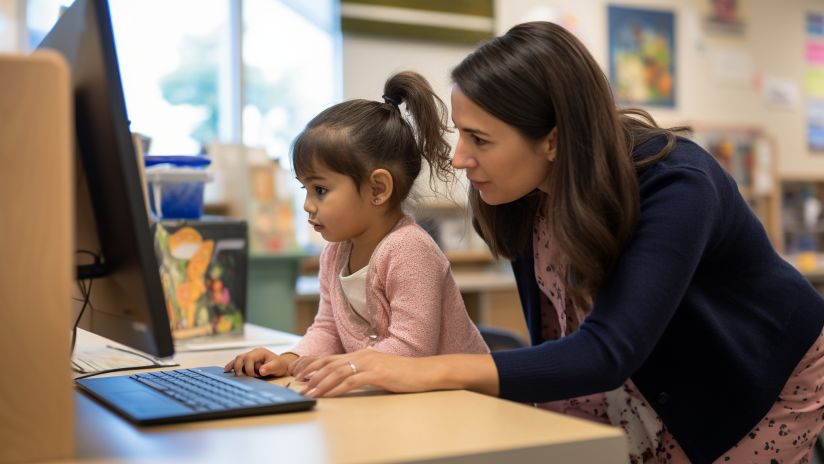Alannah & Madeline: helping fight fake news

Learning responsible digital citizenship
Since 2020, with support from the Telstra Foundation, Alannah & Madeline Foundation has been working with media literacy and e-safety experts, students and teachers to develop and update a series of free lessons, exercises and games.
From COVID vaccines to smartphone radiation, the warming climate to the impacts of AI, refugee crime to Aboriginal welfare spending – no part of our national conversation has been spared the contributions of subjective social media commentary and sensational fake news.
“These days children want to have a device earlier and earlier,” says Emily Wilden, former Program Advisor, “so no age is too early to teach our kids how to safely navigate the Internet, interpret what they see, and know how to deal with it responsibly.”
Starting safe habits before school even starts
As one of Australia’s leading child rights charities, Alannah & Madeline Foundation is perfectly placed to bridge the gap between children’s safety and the minefield of fact, fiction and half-truths that litter the Internet.
In 2020, following research confirming that many Australian children are online even before they begin school, the Foundation joined forces with the eSafety Commissioner’s Office and the Australian Federal Police to produce a series of online resources to teach children as young as four how to navigate the internet safely.
The result was Playing IT Safe, an inventive, endlessly entertaining program of activities that early years educators and parents can use to start serious conversations in a fun way – whether mapping online pathways through a maze of cardboard boxes, getting friends consent for snapping photos, using passwords to navigate around a classroom or learning about pop-ups with annoying characters getting in your way.
Developing essential critical thinking skills
At the same time, the Foundation launched the country’s first platform to teach Year 7-10 students critical thinking skills around how they consume and create digital media. The eSmart Media Literacy Lab does everything its title suggests, with fun quizzes on fact, opinion and media agendas for Year 7-8 students, and more serious lessons on the personal and ethical implications of misinformation for Years 9-10.
“We’re very aware that the curriculum is jam-packed by the time you get to middle high school,” says Erin Pearson, Senior Advisor for Learning, “so we’re constantly working to make sure our lessons resonate with students of different ages and are relevant to other topics teachers are delivering.”
Trouble in the classroom
The need for this instruction has never been more urgent. With increasingly cunning AI and ‘recommender’ algorithms, research shows nearly two-thirds of Australian teens aged 13-16 access their news through social media – often paying little or no attention to its source.
A 2020 survey from University of Western Sydney [PDF, 422KB] found that only 36 percent of children aged 8-16 said they knew how to tell ‘fake’ news from ‘real’ news, up just 2 percent from 2017. “Despite widespread concern about ‘fake’ news… many young people are not getting formal education about news media at school,” the researchers wrote. “This lack of news media literacy education in classrooms is troubling.”
Fuelled by this alarming picture of teens using Instagram and Snapchat for their news, Telstra Foundation funded Alannah & Madeline Foundation to host a series of nationwide workshops to canvas direct feedback from teachers on the impacts of its resources. Since late last year, 25 workshops have been held on the Media Literacy Lab (MLL) and the findings used to inform an overhaul of the resources to include new topics, channels and threats facing teenagers, while a further 25 workshops have been held with kindergarten and early years educators to canvas feedback on a suite of new Playing IT Safe resources.
In these challenging times, where a global ‘infodemic’ of misinformation often skews the facts, there has never been a more important time for media literacy education
- Ariana Kurzeme, Director of Policy and Prevention, Alannah & Madeline Foundation
A continuous evolution
To date, 446 high schools around the country have registered to use MLL’s resources, and the exercises and activities are being continuously updated to address new social media channels, ‘deepfake’ technologies that manipulate photos and videos, and chatbots that mimic human users. “With AI and unscrupulous algorithms in the mix, there’s so much more content out there, a lot of it not even written or curated by humans,” says Erin.
Alannah & Madeline Foundation’s team has also been field-testing MLL’s new resources with researchers at the University of Canberra’s News and Media Research Centre, who test them against best-practice frameworks, as well as a series of ‘guineapig’ schools that have been trialling the materials with Grade 9 and 10 students in Victoria, Tasmania and NSW.
Successfully identifying red flags of misinformation
One of those students is Sasha Taylor-Holmes from Daylesford, who like most 15-year-olds relies on social media for “virtually everything”. Sasha says the latest Year 10 module in the Lab really resonated with him, particularly the exercises pointing to ‘red flags’ of misinformation.
“Quite often I’ll read stuff and, straight away, I’ll think that’s political propaganda or a conspiracy theory,” says Sasha. “But sometimes it can be hard to tell, so it’s useful to have a list of warning signs around the sources or experts quoted, or more obvious signs of dodgy posts, like poor grammar or anonymous authors.
“If you share posts that are doubtful, it can affect people’s trust in you, or make them share that misinformation more widely… I don’t think there can be anything worse than losing a friend because you disagree on a ‘fact’ that turns out not even to be true!”
A new generation of advocates
Once they’ve completed evaluating their foundational modules, the team will begin developing a new series of resources that applies their principles to specific misinformation challenges. As well as examining the impacts of AI in their program, the content team are also looking at the potential for lessons in other languages, and exercises that can be read by screen-readers and other accessible technologies.
Ultimately, says Erin Pearson, the Media Literacy Lab, Playing IT Safe, eSmart Schools, and the Foundation’s other programs hope to go further still.
“In another year or two, I hope we’ll be developing resources to help high school children become prominent advocates for the digital rights of their peers – adding their voices to national efforts to identify and eradicate specific incidents of misinformation.”
Media literacy sites
There’s a wealth of free resources and information available, for both students and teachers.
eSmart Media Literacy Lab
Information and resources that help young people think critically and be active online citizens through their Lab resources and teacher webinars.
Visit the eSmart Media Literacy Lab
Playing IT Safe
Play based activities that help young children understand digital technologies. Access information on their program resources and online workshops.
About Telstra Foundation
Through the Telstra Foundation, we invest in social innovation enabled by technology. We’re focussed on youth wellbeing and building digital capacity in young people and the non-profit organisations that support them.
